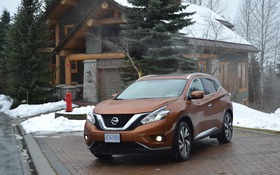2015 Nissan Murano: Gotta Love Its Style!

| Strong points |
|
|---|---|
| Weak points |
|
After it was introduced in 2003, the Nissan Murano quickly made a name for itself among intermediate SUVs. People loved its modern lines and exhilarating ride. The second generation didn’t have it as easy, mostly due to the increase in competition from other manufacturers. The Rogue and the Juke were added to the Nissan family, and the Pathfinder dropped its 4x4 credo to become a seven-passenger urban SUV.
This prompted Nissan to position the Murano at the top of its line and make it the brand’s leading SUV. But changing the status of an existing model is hard, especially in the eyes of buyers. Plus, the Murano is rubbing shoulders with its slick cousins from the Infiniti division. The Murano’s toughest rivals are the Ford Edge, Toyota Venza and Hyundai Santa Fe Sport.
True to the concept
The third generation was released for 2015 and it respects the same philosophy as its predecessors. The most notable changes serve to enhance the vehicle’s high-end aspirations. Style-wise, the 2015 Murano is heavily inspired by the Resonance concept that was presented at the Detroit Auto Show in 2014. In fact, it’s unusual to see a production vehicle keep so many aspects from the original concept. Kudos to Nissan for daring to create a distinctly different SUV; it’s not as round as other vehicles in the category and its angles are much more accentuated. In front, you’ll recognized the V-shaped grille and boomerang headlamps—two characteristics that are bound to be adopted by other models, too. The rear treatment is the most impressive aspect and is sure to garner the most widespread praise.
Compared to the last generation, the new Murano is slightly bigger. Now 65 mm longer and 33 mm wider, its interior is somewhat more spacious. If the roofline seems lower, it’s because Nissan chopped off 10 mm in height (a small victory for the vehicle’s stylists).
Inside, the cabin has been updated and the luxury factor has been stepped up. The instrumentation was revised and now looks a lot more Infiniti-esque. There’s a seven-inch screen that displays all kinds of information, depending on your preferences. The steering wheel is classic Nissan, with a wide spoke and good grip. In the middle of the dashboard, the A/C and radio controls surround an eight-inch touch screen that is easy to use. Interestingly, all trims come with a factory-standard navigation system—more proof of the Murano’s special status. As for ergonomics, the only button that seemed misplaced was the engine start button. Instead of being on the console near the steering wheel, it’s located in the middle and very low down. Cargo space is about average, but the plunging roofline will make it hard to load taller items.
Same old mechanics
If you were thinking of choosing the 3.7-litre V6, think again. The manufacturer has decided against offering more power and instead called on its darling 3.5-litre engine for all four trims (S, SV, SL and Platinum). With 260 horsepower and 240 lbs.-ft. of torque, this mill is mated to an Xtronic continuously variable transmission. The transmission has been tweaked for improved performance and to simulate some of the shifting in a traditional automatic. All this is a little less powerful than the Ford Edge’s V6, which delivers 285 horsepower and 253 lbs.-ft. of torque.
What’s new this year is that the S trim now only comes with front-wheel drive. This marks a first for the Murano and helps get the starting price down to $29,998 and fuel consumption down to 8.2 L/100 km. With the SV, you get a choice of FWD or AWD, while the Murano SL and Platinum come standard with AWD. The other differences between the trims are essentially the equipment. The one that we figure offers the best value is the SV AWD, as it comes with all the necessities at the reasonable cost of $34,998.
On the highway
Once you slip into the driver’s seat, you’ll notice that visibility is great—in stark contrast with many of today’s rounded SUVs. The steering column is both telescopic and adjustable to help you find a good driving position, all of which translates into a more comfortable experience. And speaking of comfort, the Zero Gravity seats are so lovely, they really take the edge off during long drives. Apparently, these advancements in comfort actually come from a NASA program.
Obviously, the Murano is devoid of the “Z” DNA that characterizes Nissan’s sport models. The vehicle takes comfort much more seriously than it does dynamism. If you’re looking for an SUV that handles like a car, look elsewhere. The steering and suspension are tuned for comfort, and despite all the technology on board, there’s no system to customize the handling. We would have really liked a Sport mode!
The Murano’s power is just barely adequate, despite the fact that the vehicle managed to shed 146 lbs. Up in the mountains, the engine huffed and puffed, and we weren’t even carrying that much gear with us. Fortunately, the transmission is extremely effective, maximizing the available torque and offering rapid response times. We recorded an average of 11.2 L/100 km, which is reasonable for an SUV of this size, and we probably could have done even better. All-wheel drive is a must, as it significantly improves the Murano’s handling when the road is slippery.
Nissan has managed to make the Murano just as luxurious as many other well-known SUVs while ensuring that its price remains enticing. The only thing lacking is that much sought-after prestige.











